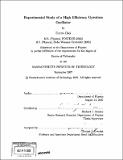Experimental study of a high efficiency gyrotron oscillator
Author(s)
Choi, Eunmi, Ph. D. Massachusetts Institute of Technology
DownloadFull printable version (22.23Mb)
Other Contributors
Massachusetts Institute of Technology. Dept. of Physics.
Advisor
Richard J. Temkin.
Terms of use
Metadata
Show full item recordAbstract
High power, high frequency gyrotrons used in plasma heating must achieve the highest possible efficiency in order to reduce system size and cost and to minimize thermal and mechanical problems. This thesis presents an experimental study of efficiency enhancement in a 1.5 MW, 110 GHz gyrotron oscillator, which operated at 50 % efficiency with a single-stage depressed collector. We present the design and detailed experimental results of a new low ohmic loss cavity, a four-mirror internal mode converter and a single-stage depressed collector. The low ohmic loss TE22,6 cavity, designated "V-2005", was designed using the code MAGY to have a Q factor of 830, which would be suitable for CW operation in an industrial gyrotron. The cavity was first tested in the axial configuration, in which the output waveguide also serves as the electron beam collector. In 3 microsecond pulsed operation at 97 kV and 40 A, an output power of 1.67 MW at an efficiency of 42 % was obtained without a depressed collector. The V-2005 cavity efficiency exceeds that of the older "V-2003" cavity by 5 percentage points. The enhanced efficiency of the V-2005 cavity may be understood by analyzing the start-up scenario of the cavities. During start-up, the V-2003 cavity suffers from strong mode competition with the TE19,7 mode, resulting in a relatively low efficiency, while the V-2005 cavity has an absence of such mode competition. The experimental mode maps (regions of oscillation vs. magnetic field) obtained for the two cavities are in excellent agreement with the start-up simulations. Following the axial configuration experiments, the experiment was rebuilt with an internal mode converter consisting of a launcher and 4 mirrors, and with a single-stage depressed collector. An output power of 1.5 MW was measured. The internal mode converter operated at 90 % efficiency. When the depressed collector was run at 25 kV, an overall efficiency of 50 % was achieved. An aftercavity interaction (ACI) was investigated as a possible cause of efficiency reduction in the gyrotron. (cont.) The ACI occurs when the spent electron beam interacts at cyclotron resonance with the traveling output microwave beam in a region of lower magnetic field just after the cavity. The presence of the ACI was identified from the comparison between simulation results and the measurement of the depression voltage as a function of beam current. Future research should consider ways of eliminating the ACI, ways of improving the internal mode converter, and the use of a two-stage depressed collector.
Description
Thesis (Ph. D.)--Massachusetts Institute of Technology, Dept. of Physics, 2007. Includes bibliographical references (p. 185-193).
Date issued
2007Department
Massachusetts Institute of Technology. Department of PhysicsPublisher
Massachusetts Institute of Technology
Keywords
Physics.